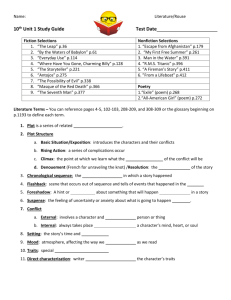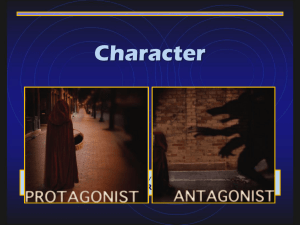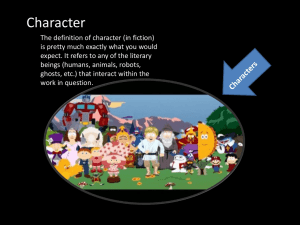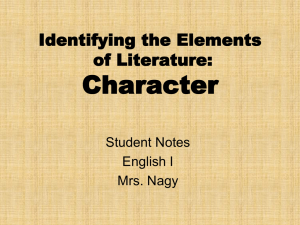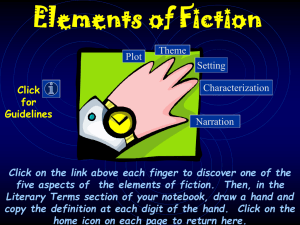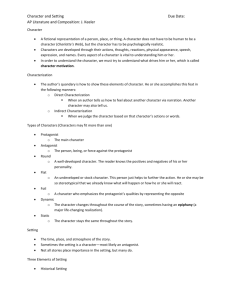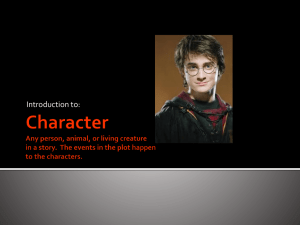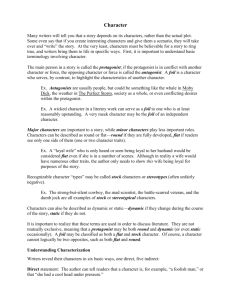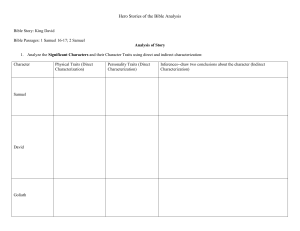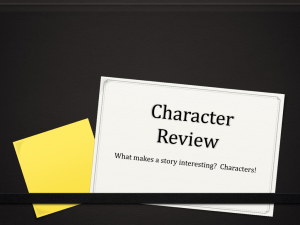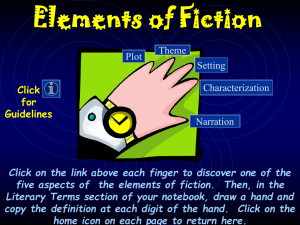Character
advertisement
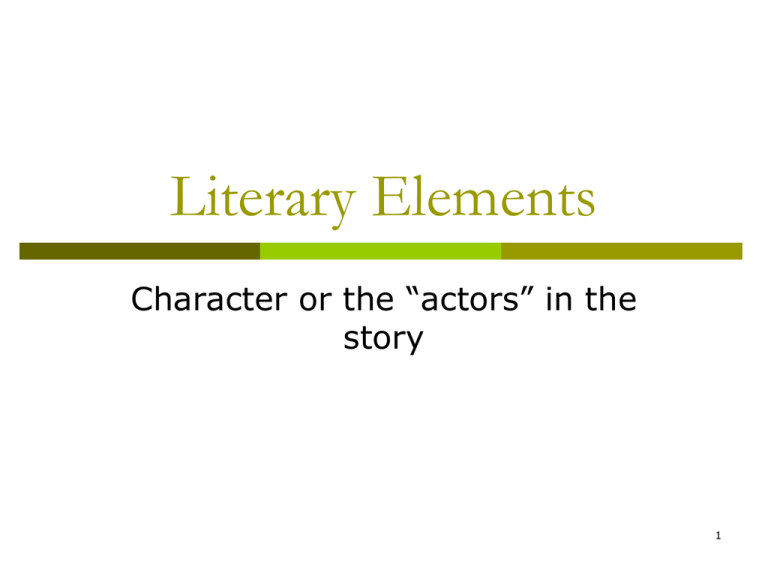
Literary Elements Character or the “actors” in the story 1 Character Denotation As a literary term, refers to a Person An animal Monster or beast A fantastic creature in a story, poem, novel, or a play. A writer who is adept in the creation of characters is said to excel at “characterization.” If these characters appear particularly realistic, the characters are said to possess a sense of “verisimilitude.” 2 Real Life and Fictional Characters One of the marvels of literature is that writers can teach us about real people and about human nature by creating and presenting their imaginary characters. One reason we love literature is that we experience and come to know “people” whom we will never otherwise “meet.” Getting to know characters such as Don Quixote, Hester Prynne, Hamlet, Jay Gatsby, and Holden Caulfield enriches our lives. 3 The Difference. . . . When we say about a real person, “He’s a real character,” we mean that he has notably unique or conspicuous traits. All characters in fiction have chosen traits and perform actions the author has chosen, eliminating other possible traits and actions to highlight certain aspects of that one character. Some characters seem lifelike or true to life while others may seem fantastic, so imagined that we would never really expect to meet such a real person in our own lives. 4 . . . is Choice and Arrangement Fiction and poetry are art. Characters are made, artificial representations. Authors carefully choose the background and circumstances in which they place their characters. In doing so, they eliminate the more trivial everyday occurrences which tend to clutter the scenes in our own everyday lives. This is why literary characters are so different from the rest of us. Just about everything they do and say may seem important and interesting! 5 Everything Matters In fact, since authors choose their characters’ words and actions, those authors consider everything a character says and does important. And so should we. It’s helpful, then, to pay close and special attention to what each character says and does. Such attention is crucial in a short story because no character is really “on stage” for very long. Pay special attention to repetition of images or patterns (motifs) in relation to any character. Such images may provide insight into that character’s personality. 6 Ways to Characterize (STEAL) Speech What a person says and how they say it Thoughts and Feelings Thoughts and feelings of a character are defining. Making note of when and where characters experience these thoughts and feelings. Effect on Others/How Others React We can learn about a character when another character or the narrator says something about him or her. We can also learn about the character by what that character says about another character in the story. Actions We know much about a person by the way he or she behaves. If the person cries often, we assume something about his or her character. If a man is always breaking up with his girlfriends, there is something we can assume about him, etc Looks A character's appearance is telling. Observe the qualities of appearance the author provides. Analyze how the appearance develops the character. Name (additional) One possible place to look for analysis is in the names of the characters. Is there some biblical or mythological reference? Does the sound of the name itself suggest an emotion or attitude? Charles Dickens is famous for defining names: Lucy is “the light” in the characters’ lives, Oliver Twist experiences many turns of fates, Mr. Striver is an amoral, ambitious lawyer, Sidney Carton lives his life like he is in a box.) 7 Character Building An author uses two methods to build character: direct characterization or indirect characterization. Direct Characterization is when the author tells the reader about the character. There is no guessing or inference involved, rather the qualities are simply stated. Ms. Gerber is old; Jenn is beautiful; Nareg is a simpleton. Indirect Characterization is when an author shows the reader the character in action and the reader must infer the character’s qualities. Ms. Gerber walked with the dinosaurs; Jenn received 14 invitations to the prom from 14 celebrity hunks; Nareg ate paste for lunch. 8 Character by Role Protagonist: the central character(s) But a protagonistiscan also be antihero: an assassin, a simpleton, a serial killer, anobject) undead in (person, animal, or personified vigilante, or head of a drug cartela -protagonist all a the plot's conflict. Though protagonist has to be is the character or can be a hero- noble, and admirable - like characters who command the central focus Maria Von Achilles Trapp Cady James Heron Bond Buffy the Superman Vampire Slayer Christine Collins Rooster Cogburn 9 Character by Role Antagonist: the force in conflict with the protagonist. It is not always the classic bad guy. It may be society, nature, or fate, as well as another person. It can also be the protagonist's own self, if he or she has an internal conflict. 10 Character by Role Character Foil: a person, thing, or force present in the story to illuminate the traits of another character, thing, or force. It is not always the opposite, but it may be. 11 Character by Change and Development Static Character: is one Round Dynamic Flat Character: Character: Character: isa not threeisfully one who does not experience a dimensional who developed; experiences character, we know a basic sufficiently only change basic character change complex in one character side asof tothe through be character believable the as a during the course of events the person of (very the with story. good, allThis bad, the change depth funny, and is story. In current fiction, unpredictability mainly gloomy internal – the character that andcharacter real maypeople is be is an unchanged notone always indication have, sudden, one-dimensional). but having thean events “more Flatfacets” of the of the quality of appear the work than plot characters ashould flat character. make often it seem as as it once did. can inevitable. minor players Audiences inToday, a story we or as appreciate humor appreciate simplistic creatures andthe identify in withora irony of a character who character children’s who fairylearns tales. from These experiences multiple experience characters are adapts the conflicts and andsometimes crisesto and changes called (be they characters. or thenstock returns topositive the same negative changes). behavior that triggered the action of the story (example: Dumb and Dumber) 12 Stock Characters Stock characters are those types of characters who have become conventional or stereotypical through repeated use in particular types of stories. Stock characters are instantly recognizable to readers or audience members. Stock characters are normally one-dimensional flat characters, but sometimes stock personalities are deeply conflicted, rounded characters. Some stock characters include High school types - jock - geek - misfit - rebel - beauty queen 13 And More Characters The Anti-Hero The Symbolic Character 14 Types of Conflict – Know thy Antagonist Remember types of conflict occurring in a short story: Internal Conflict (the “your-own-worse-enemy” scenario) Person vs. self External Conflict Person Person Person Person Person vs. vs. vs. vs. vs. person nature society fate technology __________________________________ 15 Now It’s Your Turn A rich array of characters is essential to a story, and understanding character or the way an author characterizes is key to enhancing your enjoyment of a work of fiction. With a partner identify at least two types of characters (from movies or television) from each of the following categories: Round Character Flat Character Dynamic Character Static Character Be prepared to provide evidence (ethos) to defend your answer. 16
